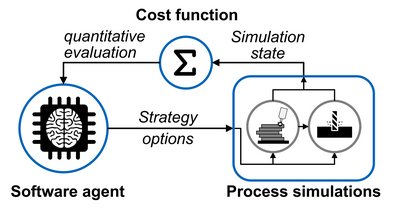CICAM – Computational Intelligence for Computer-aided Manufacturing
In recent years, additive manufacturing has become increasingly important in industrial production, particularly wire arc additive manufacturing (WAAM) and therefore also post-processing. In the research project CICAM, reinforcement learning methods are developed to be used for computer-aided process planning of the hybrid process chain, consisting of WAAM and machining.
Motivation
The various application possibilities of WAAM lead to an increased interest in the research and the industrial application of this manufacturing process. However, WAAM-produced workpieces have a low surface quality, so machining post-processing (e.g., milling) is usually required to ensure a high component quality. The complexity within CAM-planning (CAM: computer-aided manufacturing) increases significantly due to the relationships between the two processes.
Research objective
In the course of the project, an automated CAM planning of the hybrid manufacturing process chain, consisting of WAAM and machining post-processing will be enabled. Reinforcement learning allows to deal with the high complexity in CAM planning. The aim of CICAM is a prototypical implementation of modern artificial intelligence methods and reinforcement learning for semi-automated computer-aided process planning.
Approach
In the project, a software framework is developed in which a virtual agent interacts with existing process simulations. The agent identifies the best possible manufacturing strategy by selecting optimal process parameters (e.g., the feed rate).
In the first work step, the individual process models are set up. These are, among others, the deposition model for the WAAM process and the process force model for the machining post-processing. In the next step, the software framework is set up, consisting of an agent, its environment, and a cost function. The software agent can select different actions within the environment, represented by the process simulations. Possible actions are, for example, the change of the feed rate or the spindle speed. A cost function is used to evaluate the agent's selected actions. The cost function considers, for example, the machine occupancy time, the material cost, the tool wear, and the part quality. An iteration within the framework consists of the interaction of the agent with its environment, followed by the resulting simulations and a quantitative evaluation of the simulation results using the cost function. By iterating several times, the agent receives feedback on the quality of the selected actions. It learns which parameter combination leads to the best possible manufacturing strategy. Finally, the overall system is validated. Experimental tests are carried out to ensure that the framework represents the real manufacturing processes and that an application of the system is possible.
Use
CICAM uses machine learning to identify optimal manufacturing parameters for WAAM and for machining post-processing, allowing users to select and optimize the processes during CAM planning. This enables a cost- and resource-efficient production and contributes to achieving the European Union’s climate targets.
Acknowledgement
This research project is funded by the Bavarian Joint Research Program (BayVFP) of the Bavarian State Ministry of Economic Affairs, Regional Development and Energy within the funding line "Digitalization" and is supervised by the project management organization VDI/VDE Innovation + Technology GmbH (VDI/VDE-IT). We thank the BayVFP for the funding and the VDI/VDE-IT for the support as well as for the good and trustful cooperation.
